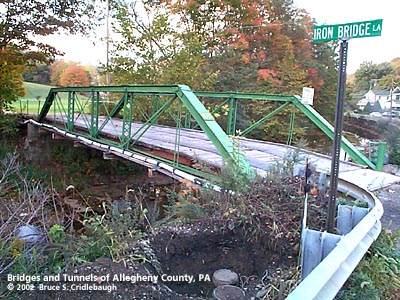| Home > All By Location regional map > New Kensington West > Iron Bridge Ln over Bull Creek | ||||
|
|

View northwest from Bull Creek Rd More detail photos OFFICIAL NAME: OTHER DESIGNATION: Iron Bridge Ln over Bull Creek nknw 604-1 LOCATION: Fawn Twp USGS 7.5" Topo Quad - UTM Coordinates: New Kensington West - Zone 17; 0604 4497 CARRIES: Iron Bridge Ln BETWEEN: -- private residences -- Bull Creek Rd [Red Belt, S.R. 1034] CROSSES: -- Bull Creek TYPE OF CONSTRUCTION / DESIGN: pony Pratt truss; wooden plank deck with steel plates aligned with wheel tracks; stone abutments LENGTH OF MAIN SPAN: 54 ft TOTAL LENGTH (including longest elevated ramp): 54 ft 13.5 ft wide deck between trusses HEIGHT OF DECK: YEAR ERECTED / ENGINEER: 1878, Morse Bridge Company of Youngstown, OH Reno, engineer ADDITIONAL INFO: Possibly the second oldest unaltered bridge in Allegheny County. The two which are oldest and positively dated by builder's plate are stone arch spans in Sewickley (1827, rebuilt 1919) and Edgeworth (1841, rebuilt 1918). A database from the Pittsburgh History and Landmarks Foundation (PHLF) lists the next two oldest spans as: 1875 Old Clairton Rd over B&O Railroad in Baldwin Borough (through truss) [demolished Sept 2002], and 1877 Thompson Run No. 2 over Bull Creek in Fawn Twp (deck girder). [The latter 1877 bridge does not have a builder's plate to confirm the date and though it also crosses Bull Creek, it is not this Iron Bridge.] The PHLF database does not list the Iron Bridge. But fortunately the builder's plates have survived to preserve the information. The next oldest bridge in Allegheny County is the 1881 Smithfield Street Bridge over the Monongahela River in downtown Pittsburgh. A metal builder's plate is attached to the downstream truss at the western portal:
A metal builder's plate is attached to the upstream truss at the western portal:
There are but a few internet references to other structures built by the Morse Bridge Company. In Pennsylvania, three are noted: 1.) The Petroleum Center Bridge over Oil Creek is a two span Pratt through truss. It featured pinned eyebars, rests on stone piers and has an open grate deck. It remains open to auto traffic in Oil Creek State Park near Titusville, PA. It is listed in the National Register of Historic Places. 2.) The Warren Bridge Company built a four span covered wooden bridge across the Kiskimenitas River at Apollo, PA. The wooden bridge stood from 1844 to 1881 when it was carried away by an ice gorge; it was replaced by a 6-span metal Pratt through truss bridge by Morse. The Morse bridge was replaced in 1937 by a series of pony spans which themselves are slated for replacement. 3.) The Coverts Crossing bridge was the first bridge to cross the Mahoning River in Lawrence Co, PA. It was built by Morse Bridge in 1887. It has been included in the Historic American Engineering Record by the National Parks Service. One additional Pennsylvania structure which was well documented by HAER: The Speicher Bridge over Tulpehocken Creek near North Heidelberg, Bucks Co., PA was built by the Morse Bridge Company in 1878 -- the same year as the Iron Bridge over Bull Creek. The Speicher Bridge was documented by HAER in 1976 before it was demolished by the U.S. Army Corps of Engineers as part of a flood control project. Other extant structures by Morse Bridge Company include: Hendricks County Bridge 216A originally located in Guilford Township on County Road 800 South -- built 1886 -- is the oldest Warren-thru span in Indiana, and it is possibly the only bridge of this type fabricated out of wrought iron. It was moved to Friendship Gardens, a park in Plainfield, IN. Spengler Road over Kinderhook Creek, Canaan, NY. A 130 foot long metal Pratt truss bridge built in 1880 by Morse Bridge Company of Youngstown, Ohio. It is listed in the National Register of Historic Places. Six Mile Creek Rd over the Shiawassee River in New Haven Twp, MI. The bridge is closed, but still stands as a metal through truss span built in 1896. FIELD CHECKED: 13-Oct-2002 INFO SOURCES: field check; Daniel Alward, venangoil.com; Historic American Engineering Record, memory.loc.gov; "Armstrong County, Pa., Her People, Past and Present," J. H. Beers & Co., 1914; Plainfield, IN website; Michigan DOT website Submit info or inquiry - share some facts or ask a question. Introduction -- Nearby Structures Page created: Last modified: 24-Sep-2001; 29-Feb-2016 |

| ||
| copyright: © Bruce S. Cridlebaugh 1999-2016 All Rights Reserved | ||||